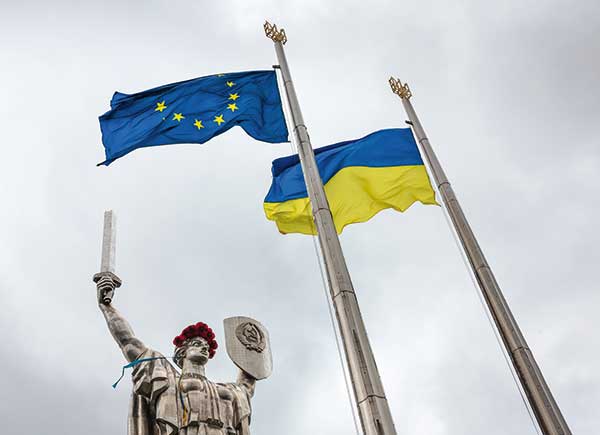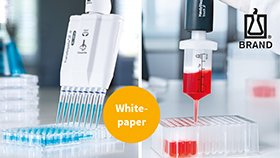Pryvit Ukrayiny
Career strategies for young European scientists
Ralf Schreck, Labtimes 04/2015
Page 1 | Page 2 | Page 3
Research and innovation have never been top priorities in post-Soviet Ukraine. Full access to EU research funds and the prospect of new legal provisions for science offer opportunities for a brighter future.
The Ukraine has a good reputation when it comes to the education and training of engineers and scientists. Just to refer to a few outstanding scholars, who have been born or worked in today’s Ukraine territory: Yuri Kondratyuk pioneered spaceflight, Igor Sikorsky invented the helicopter and Pavlovich Korolev became the leading rocket designer of the East during the 1950s and 60s. Vladimir Filatov’s name is associated with corneal grafting and tissue therapy. Microbiologist Ilya Mechnikov shared the Nobel Prize in Physiology or Medicine with Paul Ehrlich in 1908 and Nobel Laureate Selman Waksman (1952) discovered streptomycin, the first effective antibiotic against tuberculosis. Current news from the Ukraine is about the lasting armed conflict and the imminent economic collapse. What about doing research under such difficult conditions? Lab Times will provide some insights and focus on recent efforts to set the course for the future.
Scientists on the run
The armed conflict with Russia led to the occupation of almost a 10th of Ukraine’s territory. The Crimean Peninsula was annexed by Russia last year. Valuable research infrastructure has been destroyed or is no longer accessible, including the Crimean observatories in Nauchny or the Marine Hydrophysical Institute in Sevastopol. Pro-Russian separatists proclaimed the independent Donetsk and the Luhansk People’s Republics in Eastern Ukraine. More than 6,400 people have been killed and about 1.2 million people driven from their homes. Twenty-six research institutions and universities, including students, teachers and scientific staff, have had to be resettled and taken care of. For example, the Donetsk National University, one of the leading Ukrainian institutions, was evacuated to Vinnytsia in Central Ukraine. Those preferring to stay suffer additional challenges. Will the academic degrees of the new republics be accepted? How will the education and research system of Russia respond to the new competitors for limited resources, including jobs, stipends or research funds?
A yet-to-be filled emergency fund for displaced Ukrainian scientists was just recently set up by CRDF Global. CRDF, the Civilian Research and Development Foundation, is an independent US non-profit organisation, originally established in 1995 by the US National Science Foundation to support civilian research of former weapon experts in post-Soviet countries.
What else about the Ukraine?
Not too much is known about the Ukraine from afar. The 1986 Chernobyl disaster is still omnipresent. Famous sportsmen readily cross one’s mind, including the boxing Klitschko brothers, pole vaulter Sergey Bubka or footballer Andriy Shevchenko. Less known is that the composer Sergei Prokofiev, the novelist Nikolai Gogol or the politician Mikhail Gorbachev, all have roots in the Ukraine.
The already dwindling Ukraine economy is severely affected by the current war. Another major problem remains widespread corruption. In the latest Corruption Perceptions Index by Transparency International, the Ukraine was on par with Uganda and Comoros at the upper end of the most corrupt countries. The International Monetary Fund just approved a second financial aid package worth US$17 billion, to prevent the economic collapse and demanded that the Government installs an anti-corruption bureau, which will start operations with 700 employees this October. Ukraine’s currency, the Hryvnia, has lost more than 60% in value since early 2014. Gas and energy prices are sky-rocketing. More than half of the Ukraine’s economy is estimated to be a shadow economy involving not-registered and, therefore, not taxable goods and services.
Once the most powerful empire
During the 10th and 11th centuries, the empire Kievan Rus’ was not only the largest but the most powerful state within Europe. It became subsequently fragmented and dominated by varying forces, including Poland, Lithuania, Austro-Hungary or Russia. The Ukraine was a founding member of the USSR after World War I and gained independence again in 1991.
The Ukraine of today has a population of about 44 million people, which is on a steady decline. Kyiv is the capital and with close to three million people, the largest city followed by Kharkiv and Dnipropetrovsk. The political system is a presidential representative democratic republic and highly centralised. The Euromaidan Revolution in early 2014 led to an interim government and early elections. President and billionaire Petro Poroshenko is the current Head of State, whereas Prime Minister Arseniy Yatsenyuk is the Head of the Government. Legislative power is in the hands of the Ukrainian parliament, the Verkhovna Rada. The Cabinet of Ministers has an executive role. Serhiy Kvit, the former President of the National University of Kyiv-Mohyla Academy, is Minister of Education and Science. Under his leadership, a new law on higher education was introduced in mid-2014. A heavily-discussed draft law with new provisions regulating the Ukraine’s science landscape is on track.
Some progress in post-Soviet Ukraine
Rich black soils, a favourable climate as well as numerous raw materials, including iron ores, are valuable assets for the Ukraine’s economy. During the 1980s, the Republic of Ukraine accounted for about a 5th of the industrial and agricultural production in the former USSR. The progression from a planned to a market economy was slow after gaining independence. Inflation led to widespread poverty and privatisation efforts got stuck. The economy picked up speed in the early 2000s but was severely affected by the 2008 crisis. Today, the Ukraine has to import most of its oil and gas, making it vulnerable. While the service sector is dominating, agriculture and food processing in the “breadbasket” of Europe still offer some potential. For example, the Ukraine is one of the world’s largest producers of sunflower oil, sugar beets, nuts and honey. Leading industrial products include machinery, ferrous and non-ferrous metals, transportation equipment, chemicals and fertilizers. In the high-tech sector the weapon, aircraft and aerospace industries stick out.
The Ukraine is 4th in the world for its number of certified IT experts. The Brain Basket Foundation wants to train 100,000 IT specialists and make IT the number one export by 2024. In the Global Competitiveness Report by the World Economic Forum, the Ukraine was ranked close to Botswana and the Slovak Republic as 76th out of 144 countries. Good marks were received for the quality of maths and science education (30th) and availability of scientists and engineers (48th). The availability of latest technologies (113th), the capacity to attract/retain talent (131st) and wastefulness of government spending (138th) were at the opposite end of the scale.
Scientific output on decline
The overall scientific output and number of researchers in the Ukraine has been on a downturn since gaining independence. Valuable research infrastructure installed during Soviet times is hopelessly out-dated or has been suspended due to high running costs. No good basis for being competitive!
Along those lines, less visible publications in Ukraine journals have been the gold standard for promotion in the past. In the SCImago Journal and Country Ranking the Ukraine lost 20 places between 1996 and 2010. Its worldwide share of publications almost halved to 0.3%. The Ukraine of today is ranked worldwide 39th in the number of publications, 42nd in citations and 44th with respect to the h-index, reflecting productivity and impact.
In traditional areas, including materials science and engineering as well as physics and astronomy, the Ukraine has touched down between ranks 20 and 25. Due to low salaries and unattractive working conditions many talents but also established researchers have left the country, either temporarily or permanently. Another trend is to give up science for much better paid jobs in the service sector. Monthly rewards for a student fellowship, a junior doctor or a full professor account for up to €70, €180 and €320 respectively. Due to conversion into the Euro and high inflation, financial data throughout the text provide only an estimate.
Low institutional visibility in rankings
Even though Ukrainian institutions have accumulated substantial knowledge, they do not surface in global rankings. Out of 27 Ukrainian institutions listed in the worldwide SCImago Institutions Research Ranking, none are positioned with respect to scientific output in the upper 5th or concerning a share of high quality publications in the top half. Higher education institutions are also not represented in major university rankings, such as the Times Higher Education World University Rankings, the Academic Ranking of World Universities or the CWTS Leiden Ranking.
Official statistics reveal that more than a half of all universities do not perform research activities. Institutions, such as the National Mining University in Dnipropetrovsk, the Kharkov National University of Radio Electronics or the Kiev International University of Civil Aviation, are highly specialised, which provides no competitive edge, if compared to larger universities abroad offering the full spectrum of disciplines. In addition, the Ukraine is not able to score in specific criteria, such as the number of Nobel Laureates or renowned scholars from abroad working in the Ukraine. Nevertheless, in the Quacquarelli Symonds (QS) World University Rankings, six institutions that light up include the Taras Shevchenko National University of Kyiv (rank 421-430), the V. N. Karazin Kharkiv National University (rank 481-490) and the National Technical University of Ukraine “Kyiv Polytechnic Institute” (rank 551-600).
Page 1 | Page 2 | Page 3
Last Changed: 14.07.2015







